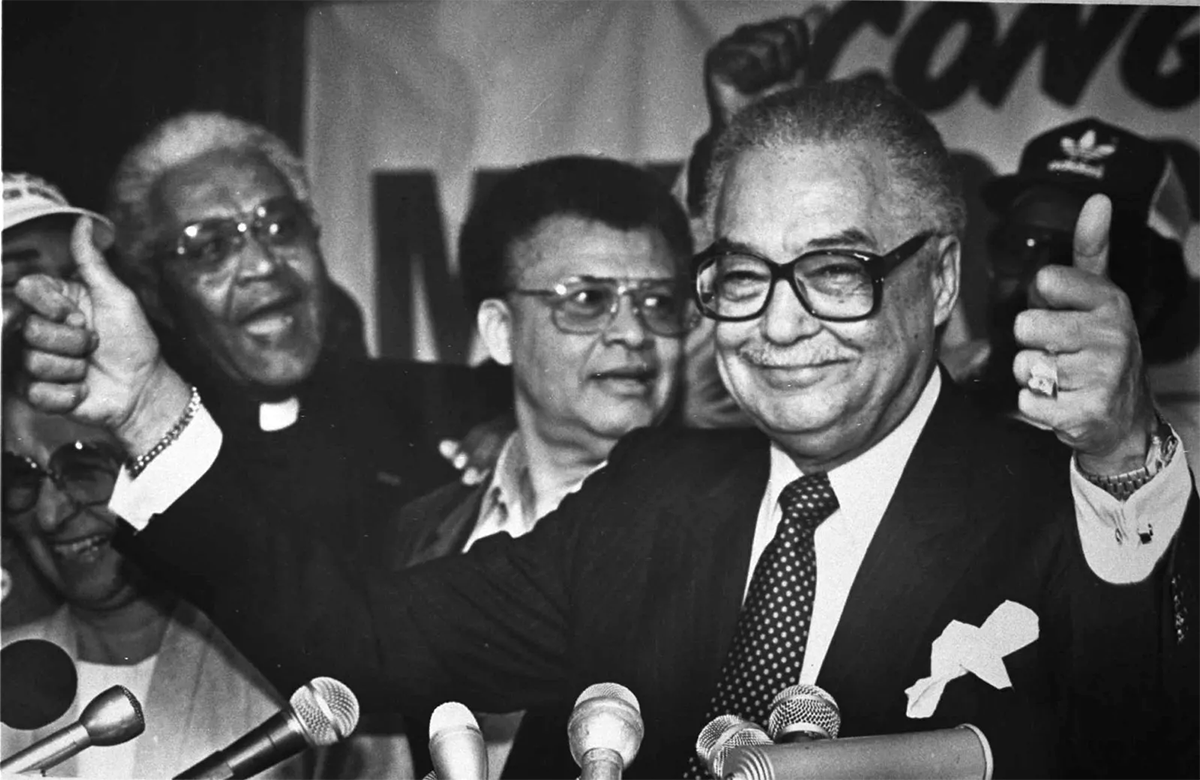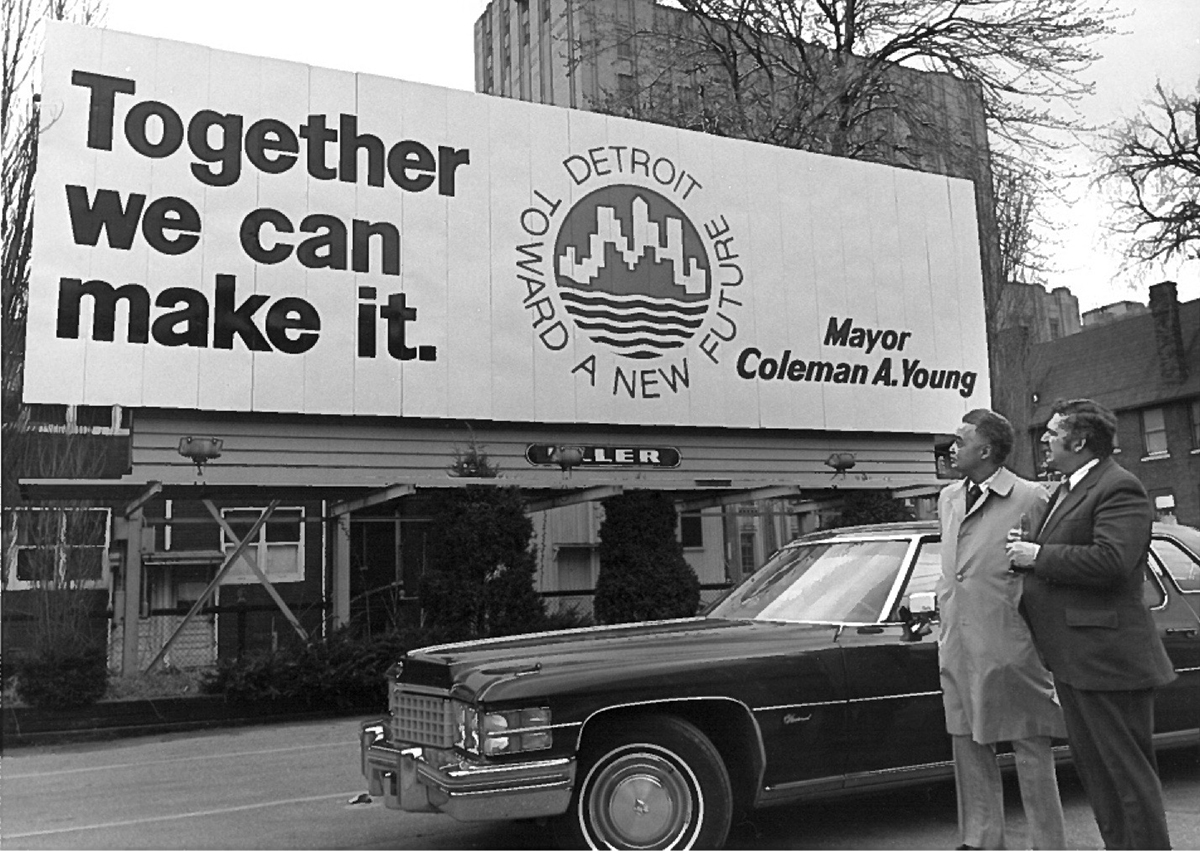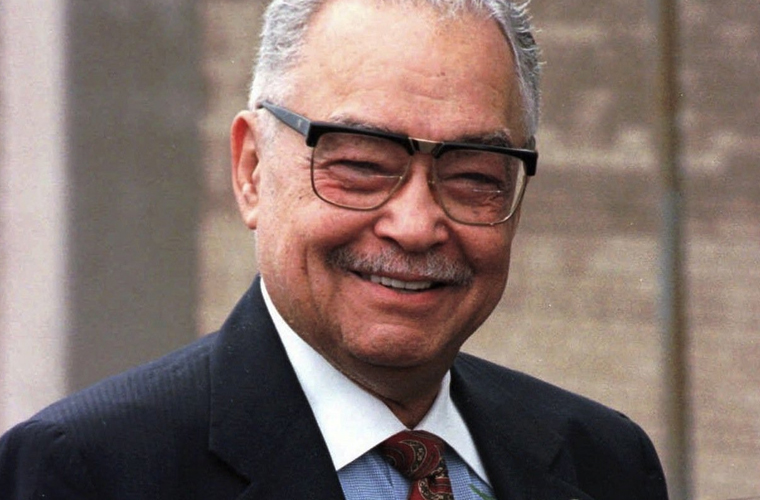Born in Tuscaloosa, AL, on May 24, 1918, Coleman Young was the oldest of five children born to Coleman and Ida Reese (Jones) Young. His family moved to Detroit’s “Black Bottom” neighborhood when he was five. “Black Bottom” was the center of African American culture and politics in segregated Detroit in the era before World War II. Young’s father set up a tailor shop and also worked for the post office. Young attended a Catholic elementary school and Eastern High School, graduating with honors. Working on the assembly line for the Ford Motor Company, Young took part in the sitdown strikes of 1937. He served in World War II as a second lieutenant and bombardier-navigator. During the postwar period, Young worked as a union organizer for the Congress of Industrial Organizations but was fired because he clashed with union leader Walter Reuther.
In 1951 Young was executive secretary of the National Negro Labor Council, which the Truman administration labeled “subversive.” In the McCarthy era, Young was investigated by federal authorities as a suspected Communist sympathizer. In the 1950s, Young worked in a laundry and a butcher shop, ran his own cleaning service, drove a taxi, and sold insurance. In 1960, he plunged into politics, winning a seat as a delegate to the Michigan Constitutional Convention. He was elected to the Michigan Senate in 1964 and became a Democratic floor leader during his nine years there.

When Young first ran for mayor in 1973, Detroit’s population was about 50 percent African American. Young, getting an estimated 92 percent of the African American vote, narrowly beat a white Detroit police chief, John F. Nichols, who got 91 percent of the white vote. Nichols ran a “law-and-order” campaign, playing on fears of unrest that remained from Detroit’s destructive 1967 riots, while Young attacked the police force, and particularly its special tactical crime unit STRESS, as a racist organization. After his victory, Young, the first African American to be mayor of Detroit, took a harder line on crime, hoping to blunt Detroit’s reputation as the murder capital of the nation. He told a prayer breakfast meeting: “I issue an open warning now to all dope pushers, to all rip-off artists, to all muggers. It’s time to leave Detroit. I don’t give a damn if you are black or white …hit the road!”
Often profane and always blunt, Young was one of the first African American big-city mayors to achieve national prominence. One of his major goals was to transform the police department from one dominated by whites into an institution more closely reflecting the racial makeup of the city, which was becoming increasingly African American. He blistered white police officers who lived in the suburbs, saying they were like an “army of occupation” and charging: “They don’t give a damn about the city. They come in and kick some ass and go back” to their suburban homes. Young suspended police living outside the city demoted others, promoted a large number of African Americans through the use of the quota system, recruited women and minorities for police work, and disbanded STRESS. The mayor cited better police-community relations and the integration of the police force and other institutions as his administration’s proudest achievements.

Young was re-elected in 1977, 1981, 1985, and 1989 by sizable majorities, with little more than token opposition. In Detroit’s African American community, Young was a heroic figure. He created a formidable political machine and raised millions for his campaign war chest. He imposed a ban on city workers speaking to reporters and he became famous for his obscenity-laced attacks on political opponents. Young became a force in state and national politics, trying to get assistance for Detroit’s daunting urban problems during an era of decreasing aid to cities from the federal and state government. In Michigan, he became a symbol of the state’s deep racial divisions, despised by many white suburbanites and praised by African Americans and liberal whites.
Abandoned in the decades after the 1967 civil disturbances by most of the city’s white, middle-class residents and most of its businesses and investors, Detroit in the 1970s and 1980s was reeling from the rapid decline of the domestic auto industry, which had made Detroit world-famous as the Motor City. With almost all its auto factories closed, Detroit struggled with massive unemployment, abandoned housing, poor schools, lack of public transit, and rampant crime. Young was saddled with these deep-rooted problems during an era where urban issues moved from near the top of the national agenda to near the bottom. His major strategy to reverse Detroit’s decline was to court business leaders in efforts to rebuild downtown, hoping to recapture businesses and jobs. He forged solid relationships with top automotive and financial leaders and tried to promote Detroit as a “renaissance city.” Young pointed to the building of the Renaissance Center, an office hotel tower on the Riverfront, as the first step to a downtown revival that never lived up to expectations.

An important fight that defined Young’s priorities was his deal to bring a new General Motors assembly plant to an area known as Poletown. The city, state, and business leaders devised a plan to raze an old but relatively stable mixed-ethnic community to clear land for the plant, touting the promise of thousands of jobs. Community activists opposed the destruction of the neighborhood. Young prevailed, touting the new GM plant as a symbol of the city’s revival, but the economic spin-off promised never materialized, and fewer than half the promised jobs were created after the plant opened.
In his last three terms as mayor, Young’s administration was plagued by allegations of fraud, bribery, and mismanagement. The mayor remained blunt and unapologetic, and his combative relations with the press worsened. During Young’s last term, his police chief was indicted in a financial scandal amid allegations that Young had operated a slush fund from his campaign war chest. Young was plagued by poor health and seemed ever farther removed from the everyday problems of the city. A growing number of critics, including a younger generation of African American politicians and other community leaders, attacked the Young administration for neglecting the city’s neighborhoods, not tearing down abandoned houses, allowing basic city services to decline, and failing to stem crime.
Undaunted, Young remained until the end of his tenure an outspoken booster of Detroit and a critic of his many political opponents. In his 20 years in office, he transformed Detroit from a city run by whites to a city led by African Americans, in government, the police department, the schools, and business. But he failed to make much headway against the daunting social problems that plagued a city abandoned by its major industry and the owners of its wealth. In 1993, Young retired and a new mayor, Dennis Archer, was elected. Archer immediately adopted a more conciliatory attitude toward suburbanites. After his retirement, Young remained outspoken on issues such as the 1995-1997 Detroit newspaper strike and his political machine continued to be a major factor in Detroit politics.

